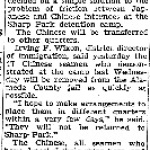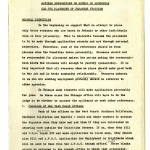Immigration and Naturalization Service
During World War II, the Justice Department's Immigration and Naturalization Service (INS) interned nearly 32,000 Japanese, German, and Italian " enemy aliens ," most of whom resided in the continental United States and the territories of Hawai’i and Alaska but thousands of whom were deported from Latin America. In addition to its regular facilities, the INS and the U.S. Army operated dozens of permanent and makeshift internment camps in order to accommodate large number of internees. By using immigration law during and after the war to detain foreign nationals, the Justice Department avoided a host of constitutional concerns, including due process of law.
In 1940, President Franklin Roosevelt transferred the Immigration and Naturalization Service (INS) from the Labor Department to the Justice Department, marking a shift in thinking that did not originate in—but was deeply entrenched by—World War II. Government officials questioned how a department focused on the nation's employment could also handle problems related to the nation's security. When Roosevelt submitted Reorganization Plan No. V to Congress in May 1940, therefore, he claimed that given "the startling sequence of international events," the INS ought to be "closely integrated" with the activities of the Justice Department, where it could provide "more effective control over aliens." [1]
Within the Justice Department, the INS joined several agencies involved with plans to monitor individuals and organizations of designated foreign nationals. Roosevelt authorized the Federal Bureau of Investigation (FBI), for example, to conduct "foreign intelligence work" in the Western Hemisphere. Under J. Edgar Hoover , the FBI created a Custodial Detention List of suspected individuals for possible arrest in time of war. It also established the Special Intelligence Service (SIS), which stationed agents—known as "legal attaches"—at U.S. embassies throughout Latin America. Another agency, the Special Defense Unit (SDU), reviewed FBI intelligence and developed a three-tiered classification system–A, B, and C–to rank organizations and their members in descending order of "dangerousness." As early as July 1941, the Justice Department planned that the FBI would arrest dangerous suspects and that it would turn them over to the INS for internment. [2]
Despite considerable planning, the unpredictability of war required the INS to assume responsibilities that its administrators had not anticipated. Immediately after the Japanese attack at Pearl Harbor on December 7, 1941, FBI Director J. Edgar Hoover authorized the FBI to arrest all Japanese who had been identified under the government's classification system and to deliver them to the INS. [3] Several hundred Japanese on the mainland were arrested without a formal warrant. The next day, President Roosevelt signed a proclamation invoking the Alien Enemy Act of 1798 , which stated that in times of war, "all natives, citizens, denizens, or subjects" of an enemy nation "shall be liable to be apprehended, restrained, secured, and removed as alien enemies." By December 10, the INS had detained 1,291 Japanese, 857 Germans, and 147 Italians, henceforth known by their legal categorization, "enemy aliens." [4]
Except in military zones, the Justice Department's Immigration and Naturalization Service retained custody over "enemy aliens" and held them in "detention stations," "detention camps," "internment camps," and in some cases, city and county jails and hotels. [5] Its immigration stations were located in Gloucester City, New Jersey; Detroit, Michigan; East Boston , Massachusetts; Ellis Island, New York; Seattle , Washington; San Pedro , California; and San Francisco , California. [6] But the INS appropriated other sites, such as a Civilian Conservation Corps (CCC) camp, to accommodate the large influx of detainees. In September 1942, the INS listed five detention and internment camps, including Fort Stanton , New Mexico; Kenedy , Texas; Santa Fe , New Mexico; Missoula , Montana; and Fort Lincoln , North Dakota. [7]
For the detained enemy alien, the next step in the internment process was to appear before a non-legal “hearing board” composed of civilians with the task of recommending one of three outcomes: release, parole, or internment. The case against the detainee rested on “evidence” from FBI files and the questions U.S. officials posed concerned the detainee’s nationality, residence, organizational membership, international travel, and loyalty. The detainee was permitted neither counsel nor witness for defense. [8] If the hearing board determined that a male detainee was "dangerous," the Justice Department transferred that individual to the United States Army. Nearly one year after the United States had entered the war, the INS held 5,534 Japanese, 4,769, Germans, and 2,262 Italians. [9]
Somewhat paradoxically, the INS continued to take foreign nationals into custody, even as the threat of subversion subsided. By 1943, the army required additional holding space for Axis prisoners of war from Europe and asked the Justice Department to take custody of 9,341 Japanese and Germans back to the Justice Department between June and July of that year. [10] INS responsibilities also increased as a result of the State Department's arrangements to intern Japanese, Germans, and Italians deported from Latin America to the United States. Beginning in April 1942 and continuing until 1947, the INS held substantial numbers of Japanese Peruvians and other Japanese Latin Americans at its internment camps in Santa Fe, New Mexico, and Kenedy, Seagoville , and Crystal City , Texas.
Although difficult to calculate, ethnic studies scholar Tetsuden Kashima estimates that the Justice Department interned or had under its jurisdiction a total of 31,899 persons during World War II, out of which 17,477 were of Japanese ancestry, 11,507 were of German ancestry, 2,730 were of Italian ancestry, and 185 were of other ancestry. [11] In total, the INS operated as many as 65 facilities for the internment of foreign nationals, though many were makeshift sites to accommodate the ebb and flow of the internment process.
For More Information
Commission on Wartime Relocation and Internment of Civilians. Personal Justice Denied: Report of the Commission on Wartime Relocation and Internment of Civilians . Washington, D.C.: The Civil Liberties Public Education Fund, 1997.
Kashima, Tetsuden. Judgment without Trial: Japanese American Imprisonment during World War II . Seattle: University of Washington Press, 2003.
Ngai, Mae M. Impossible Subjects: Illegal Aliens and the Making of Modern America . Princeton: Princeton University Press, 2004.
Weglyn, Michi. Years of Infamy: The Untold Story of America's Concentration Camps . New York: William Morrow & Co., 1976.
Zolberg, Aristide. A Nation by Design: Immigration Policy in the Fashioning of America . Cambridge: Harvard University Press, 2008.
Footnotes
- ↑ The President Presents Plan No. V to Carry Out the Provisions of the Reorganization Act, 22 May 1940, The Public Papers and Addresses of Franklin D. Roosevelt , 1940 Volume (New York: The Macmillan Company, 1941), 223-229.
- ↑ Tetsuden Kashima discusses the July 1941 agreement between the Justice and War Departments in greater detail. See Tetsuden Kashima, Judgment without Trial: Japanese American Imprisonment during World War II (Seattle: University of Washington Press, 2003), 26-27.
- ↑ Kashima, 47-48.
- ↑ Ibid., 51.
- ↑ Ibid., 43.
- ↑ Ibid., 107.
- ↑ Ibid., 108.
- ↑ Ibid., 59.
- ↑ Ibid., 51.
- ↑ Ibid., 117.
- ↑ Ibid., 124-125.
Last updated June 10, 2020, 5:15 p.m..

 Media
Media







